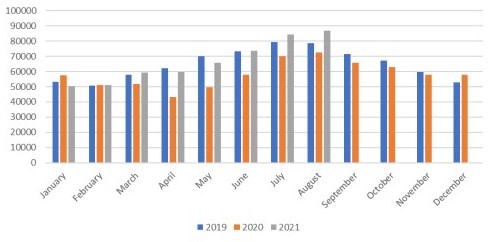With international transport at the forefront of trade and dependent on travel and human interaction, the shipping industry has been impacted both directly and indirectly from the outbreak of COVID-19.
Using data mainly from the Union Maritime Information and Exchange System (SafeSeaNet), and in certain cases combined with LRIT and MARINFO data, EMSA issued a report providing figures on the impact of COVID-19 on shipping traffic.
By analysing ship calls at EU ports it was found that the number of ships calls at EU ports fell by 10% in the 2020 compared to 2019.
The number of ships calls in August 2021 increased by 11% compared to the same month in 2019. The most significantly affected sectors have been the Cruise ships, Refrigerated cargo ships and Vehicle carriers.
Meanwhile, the number of Passenger ships, Ro-Ro Passenger vessels and Ro-Ro cargo vessels had an increase of 11%, 23% and 13% respectively.
The most affected countries are Estonia, Finland, France, Italy, Latvia, Malta, Norway, Portugal, and Spain.
By processing data from MARINFO for 2019, 2020 and 2021, the EMSA report analyses also the impact of the COVID outbreak on the activities of ships flying the flags of EU Member States in terms of calls at any port in the world
said EMSA.
The total number of calls by vessels flying the flags of EU Member States (UK excluded) in 2020 decreased by 3.5% in comparison to 2019; similarly, the related total gross tonnage decreased by 11.1%.
In particular, a significant decrease started in mid-March 2020, as an impact of the COVID-19 outbreak escalation across Europe that obliged many EU Member States to put in place lockdown measures.
From August 2020, however, this trend appeared more stable, alternating small positive and negative monthly variations.
Up to the current month in 2021 there is an overall full recovery of the number of port call with a positive 3.5% variation to the 2019 values and a decrease of -6.6% of the total gross tonnage calling.
The most significant port call decreases last month (August 2021 vs August 2019) are observed in ships flying the flags of Croatia, Bulgaria, France and Greece.
Latvia, on the other hand, shows a very significant increase this month to over the double of the calls, compared with the homologous month in 2019, followed by Denmark, Finland and Ireland.

EMSA also analyses how the shipping routes from Europe to China and from Europe to the US have been affected.
In fact, during 2020, the ship traffic from Europe to China and the US has declined when compared to same periods in 2019. In 2021 the traffic to and from China is still below the 2019 values even though increasing above the values from 2020.
However, in the traffic with the US, in particular the exports from the EU have recovered and increased to values above pre-pandemic since March 2021, while the imports from the US are now reaching the pre-pandemic values.
The EMSA analysis put further focus on ships carrying passengers which were mostly affected by COVID-19. EMSA started already in March 2020 with the analysis of cruise vessels related data producing daily a status report with the list of the cruise ships located at EU ports (moored or at anchor) and the list of sailing cruises destinated to EU ports in the coming days.
This analysis showed the growing number of cruise ships bound to EU ports and staying at ports or anchorages. The report showed that the number of Persons on Board (PoB) on cruise ships began to decrease gradually from the beginning of March 2020 (around week 10) and remained at a very low level
As the COVID-19 pandemic continued to roll, ports have faced an unprecedented number of vessels at anchor and vessels queue up waiting for a spot to unload cargo. Since the beginning of 2020 and especially since week 13 (23-29 March 2020) there is an increase number of ships “at anchor” in comparison with 2019.
Despite of the difficulties, commercial ship operations, ports and other maritime transport sectors continued to operate ensuring the movement of goods and proving the strategic importance of maritime for our livelihoods






























































